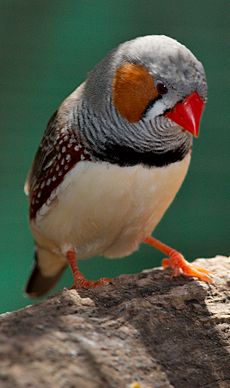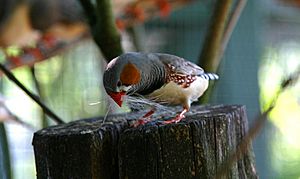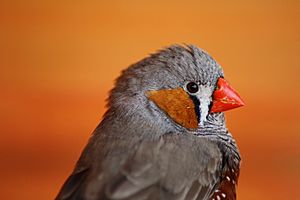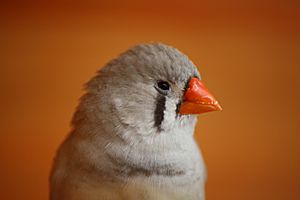Zebra finch facts for kids
Quick facts for kids Zebra finch |
|
|---|---|
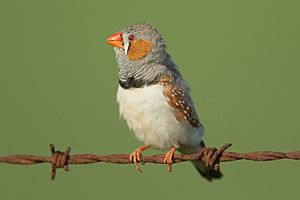 |
|
| Conservation status | |
| Scientific classification | |
| Genus: |
Taeniopygia
|
| Species: |
guttata
|
| Synonyms | |
|
Poephila guttata |
|
The zebra finch (Taeniopygia guttata) is the most common estrildid finch of Central Australia and ranges over most of the continent, avoiding only the cool moist south and some areas of the tropical far north. It can also be found natively on Timor island. The bird has been introduced to Puerto Rico and Portugal.
Contents
Taxonomy and phylogeny
The zebra finch was first collected in 1801 during Nicolas Baudin's expedition to Australia. It was described in 1817 by Louis Jean Pierre Vieillot in his Nouveau Dictionnaire d'Histoire Naturelle, where he gave it the scientific name Fringilla guttata. The Australian subspecies was then described in 1837 by John Gould as Amadina castanotis. Its current genus, Taeniopygia, was described in 1862 by Ludwig Reichenbach. It is placed in the tribe Poephilini, along with the genus Poephila, which it was previously included in; the split between Taeniopygia and Poephila is justified by 1987 study using protein electrophoresis and chromosomal banding.
There are two subspecies of the zebra finch:
- Taeniopygia guttata guttata, the Timor zebra finch, extends from Lombok in the Lesser Sunda Islands or Nusa Tenggara in Indonesia to Sermata, in addition to coastal areas around the continent of Australia.
- Taeniopygia guttata castanotis is found over the wide range of continental Australia; it is sometimes split as the Australian zebra finch.
The zebra finch likely evolved in Australia, with either northern or southeastern Australia postulated as two places where the genus arose. The present-day distribution of the subspecies T. g. guttata is likely due to a Pleistocene glaciation event where the sea level dropped between about 100 and 150 metres (330 and 490 ft), putting the coasts of Timor and Australia closer. This allowed birds swept out to sea by cyclones to see mountains near the west coast of Timor, which prompted them to make landfall on the island.
The morphological differences between the subspecies include differences in size. T. g. guttata is smaller than T. g. castanotis. In addition, the T. g. guttata males do not have the fine barring found on the throat and upper breast and have smaller breast bands.
Habitat and distribution
The zebra finch has the most extensive mainland distribution of the Australian estrilids, being found in about 75% of mainland Australia, as the subspecies Taeniopygia guttata castanotis. This subspecies is generally not found on the coasts, except for the arid western edge. As the subspecies T. g. guttata, it is distributed from the islands Lombok and Sumbawa in the Lesser Sundas east to Luang and Sermata, and south to Sumba, Sawu, Dao, Roti, Semau, and Timor.
The zebra finch (or at the very least, the subspecies T. g. castanotis) is generally found in more arid areas. The areas it chooses to occupy are close to water, and places where rain is concentrated after it falls. However, this is likely more related to the abundance of vegetation than the abundance of water as a resource in itself. Within these areas, it is found in grasslands with scattered trees and shrubs, and in open or grassy woodlands. It is also found in cultivated areas, such as rice fields It usually stays confined to the low coastal areas of the islands it inhabits, but it can move to elevations up to 2,300 metres (7,500 ft) to exploit expanding cultivation and grasslands.
Although zebra finch breeding, for example, is initiated by rainfall, Klaus Immelmann proposed that sustained heavy precipitation is detrimental to the zebra finch. This is supported by the observation that the nest does not shield the chicks or eggs from rain, and rainfall can sometimes result in clutches being abandoned. Furthermore, it is supported by Immelmann's finding that zebra finches left Wyndham after the first heavy rains in November 1959, but returned to breed in April. It is hypothesised that birds in parts of northern Australia migrate inland during the wet season from October to May, and return to the coastal regions during the dryer months.
Life cycle
The life expectancy of a zebra finch is highly variable because of genetic and environmental factors. The zebra finch may reach up to five years in its natural environment. If they are kept caged, they normally live for 5 to 9 years but may live as long as 12 years, with an exceptional case of 14.5 years reported for a caged specimen. The greatest threats to captive zebra finch survival are predation by cats and loss of natural food.
Song and other vocalisations
Zebra finches are loud and boisterous singers. Their calls can be a loud beep, meep, oi! or a-ha!. Their song is a few small beeps, leading up to a rhythmic song of varying complexity in males. Each male's song is different, although birds of the same bloodline will exhibit similarities, and all finches will overlay their own uniqueness onto a common rhythmic framework. Sons generally learn the song of their fathers with little variation. There is a critical sensitive period during which juvenile males learn their songs by imitating a mature, male tutor. Subsong (early, poorly structured vocalisations) evolve into 'plastic song'. This plastic song is variable between renditions but begins to incorporate some recognisable elements of tutor songs. A study conducted by Nottebohm et al., has shown that birds were able to successfully imitate their tutor's song after relatively short exposure (40 playbacks of the motifs lasting 30 seconds total) over the duration of their sensitive learning period. These birds eventually form a “template” of what their correct song should sound like. They rely on auditory feedback for both song learning and practice as juveniles and song maintenance as adults. Adult birds maintain their songs by correcting any deviations from their target song template. During adulthood, by around 90 days, the bird's song goes through a crystallisation phase where their song template is stable and it no longer changes.
Male zebra finches begin to sing at puberty, while females lack a singing ability. This is due to a developmental difference, where in the embryo, the male zebra finch produces testosterone, which is transformed into estradiol in the brain, which in turn leads to the development of the nervous system for a song system. There are multiple areas of the brain involved in the production of song. When a bird is singing a learned song, the HVC projects to the robust nucleus of the archistriatum (RA), which itself projects to the hypoglossal motoneurons. These motoneurons control the muscles of the trachea and syrinx. When learning a new song, the HVC sends efferents to Area X in the lobus parolfactorius, which connects to the medial nucleus of the dorsolateral thalamus (DLM). This structure connects to the lateral magnocellular nucleus of the anterior neostriatum (LMAN), which projects to the RA, and continues like a normal learned song would. The function of the various areas involved in learning is still being investigated. Area X is likely involved in the acquisition of a new song, whereas the LMAN likely serves a key role in the plasticity necessary for learning. Activation of song behaviour later depends on androgens.
Because zebra finch males learn their songs from their surroundings, they are often used as avian model organisms to investigate the neural bases of learning, memory, and sensorimotor integration. For example, studies have investigated the role of FoxP2 in song learning and have found that in young finches both knockdown and overexpression of FoxP2 in the striatal song control nucleus, Area X, prevents accurate song learning and tutor imitation. These studies also have implications for human speech. Individuals heterozygous for a point mutation in FOXP2 manifest a speech disorder. Because of similar expression patterns between humans and songbirds, the zebra finch is used as a model to study FoxP2 expression and function. The zebra finch genome was the second bird genome to be sequenced, in 2008, after that of the chicken.
The zebra finch uses an acoustic signal to communicate to embryos. It gives an incubation call to its eggs when the weather is hot—above 26 °C (79 °F)—and when the end of their incubation period is near. This call alters the growth and behaviour of the chicks, with chicks that were given an incubation call having less mass at the end of the nestling phase when they experienced higher nest temperatures. This contrasts with chicks that were not given an incubation call, which have a higher mass at the end of nestling after being exposed to high nest temperatures. Additionally, the chicks called to as an embryo are more likely to call after experiencing high nest temperatures.
Calling behaviour is used by zebra finches to negotiate parental care duties. In an experiment that delayed the return of the males to the nest, it was found that the resulting duets were shorter and calls were made more often. This is the first species that vocal negotiation over parental care has ever been reported.
Behaviour
Breeding
The zebra finch generally breeds in loose colonies of up to 50 nests (although the number of individuals in a colony can be up to about 230 when breeding, and around 350 when not), but it may nest solitarily. It usually places its nest in a thorny shrub or tree, although it will nest in other structures, natural and artificial. Often, there are multiple nests in one shrub.
In non-arid parts of Australia, colonies are often occupied year-round. During cold days in the non-breeding season, members of these colonies usually feed in flocks for about two hours, breaking up into small groups to rest, preen, sing, and court before foraging again in a large flock until about one hour before sunset, when they return to the colony. On warmer days, some of the small groups return to the colony to build nests and perform their normal activities. During the breeding season, finches finding or building a nest often return after about an hour of feeding, and on cold days they are joined by those incubating or brooding young. Pairs that have not yet laid their eggs sometimes elect to court and mate in special "courting trees" before joining the flock. In the afternoon, most pairs engage in social activities, which often take place at "social trees". The zebra finch frequently does not breed where it was born; of the ringed birds that bred in the Danaher breeding colony (36°09′S 145°26′E / 36.150°S 145.433°E) from 1985 to 1989, 24% of them were hatched from the colony or in the immediate vicinity. This natal dispersal is not sex-biased, unlike in most passerines. However, males between 36 and 50 days of age are more likely to disperse than females, although after this age, more females disperse than males. Predation is likely a major factor in coloniality; nests in the main colony suffer less predation than nests further away. Pairs with preyed-upon nests are significantly more likely to nest in a bush more than 20 metres (66 ft) away from their previous nesting plant. Another large factor is where others nest: individuals are more likely to nest closer to conspecifics. In addition, reproductive success of conspecifics may play a role in where individuals nest; a study published in 2012 found that this finch was more likely to breed near nests with chicks older than six days (used as a proxy for reproductive success because they fledge about 87% of the time).
The zebra finch builds both a roosting and breeding nest. The former is dome-shaped, has a large entrance on the side, and lacks an entrance tunnel. This nest helps the zebra finch conserve body heat (likely through its roof and walls and by allowing birds to huddle together): an individual in a roosting nest saves about 18% of the energy of one outside. The breeding nest (which generally ranges from about 12 to 24 centimetres (4.7 to 9.4 in) in length) has a small entrance followed by a tunnel about three to five centimetres (1.2 to 2.0 in) in diameter and up to eight centimetres (3.1 in) in length, which conceals the contents of the nest, leading to the egg chamber, which has (from the outside) a diameter of 12 to 20 centimetres (4.7 to 7.9 in); the latter two are separated by a raised lip, preventing eggs from rolling out. This chamber often sits on an old nest; otherwise, a foundation consisting of many short, stiff stems over horizontal branches is constructed. The walls of the nest range in thickness from one to three centimetres (0.39 to 1.18 in), with an outer layer of longer stiff and rough grass stems and an inner layer of shorter soft and fine stems. The egg chamber is also lined with soft material, such as wool and feathers. Both sites are defended during the day; but while a desperate bird is sometimes let in to the roosting nest during the night, the breeding nest is always guarded.
The zebra finch is an opportunistic breeder, initiating reproductive behaviour about one to three months after water becomes available. This is so that the young hatch when semi-ripe and ripe seeds (their primary food) become available. This finding is in line with the food quality hypothesis of zebra finch breeding, which states that dry grass seed is inadequate as a food source for nestlings, and that higher quality food (like ripening seeds) is needed to sustain them. Thus, in captivity, it can breed year round when provided with sufficient water, and it may attempt to breed several times per breeding season. Zebra finches are socially monogamous, with pair bonds lasting until the death of one of the partners, after which the widowed bird re-pairs.
The number of eggs ranges from two to eight eggs per clutch, with five being the most common number. These eggs are white or pale greyish blue in colour, and have a size of about 16 by 10 millimetres (0.63 by 0.39 in). They are incubated for 14 to 16 days. From about 5% to 11% of offspring are the result of intraspecific brood parasitism, and in cases of parasitism, there is usually only one parasitic egg per nest. Additionally, parasitised nests often have one more egg than non-parasitised nests. The female may follow a mixed strategy with relation to brood parasitism (being parasitic in addition to incubating its own clutch). From about 32% to 58% of females do this, and almost all (about 96%) lay parasitic eggs before incubating their clutch. Unpaired females sometimes lay parasitic eggs, but paired females do not rely solely on parasitism. A female that parasitised a nest in the past is more likely to do so in the future. Most of these eggs are unsuccessful; that is, the host abandons its otherwise empty nest after a parasitic egg is laid. Additionally, successful parasites are more likely to have future success from parasitism. At least during late incubation, the female zebra finch can distinguish its own eggs on the basis of odour. This method of distinction arises from the visual similarity between parasitic and non-parasitic eggs, and the cost associated with raising an egg other than one's own. When a bird is parasitised during a nesting attempt, it is less likely to be parasitised again during that season and, at the very least, during the next season (although this could be statistical noise).
Young zebra finches fledge about 17 to 18 days after hatching. They feed themselves by around 35 days after hatching, although they are still socially dependent on their parents during this time; the young become socially dependent between 36 and 50 days after hatching. They also develop sexually dimorphic plumage during this period. These finches are quick to attain sexual maturity, with most first attempting to form pair bonds and breed when they get close to 80 days in age. During the second half of the breeding season at the Danaher breeding colony, 44% of pairs attempting to breed were formed by individuals that were born earlier in the season.
Males and females are very similar in size, but are easily distinguished from one another after reaching maturity, as the males usually have bright orange cheek feathers, red beaks (as opposed to the orange beaks of females), and generally more striking black and white patterns.
Inbreeding
Inbreeding causes early death (inbreeding depression) in the zebra finch, although it does not seem to affect fertility. Embryos have a much lower survival rate, with a study finding fertile eggs from sibling pairs had only about a 25% survival rate, compared to about 41% for unrelated pairs. This early difference in survival eventually becomes null after fledging, with about equal survival rates for offspring from both sibling and unrelated pairs. Inbreeding depression mostly arises due to the expression of deleterious recessive alleles.
Diet
The zebra finch primarily eats grass seeds, feeding mostly on semi-ripe and ripe seeds (although it also takes dry seeds). The seeds are all dehusked, and are found on stems and the ground, with most being taken, at least in the nominate subspecies, from the latter. The grasses they are taken from are commonly between about 1 and 2.6 millimetres (0.039 and 0.102 in) in length, and larger and easily dehusked seeds are preferred. It supplements its diet with insects (mainly ants and termites) caught in short flights from lookout perches, in addition to flowers of the genus Chenopodium. The nestlings diet consists almost entirely of half-ripe and ripe seeds, in addition to green plant material. There are two main reasons why grass seeds are the dietary staple of the zebra finch: they are an abundant and relatively stable food source in this finch's preferred climate, and they are convenient to, for example, dehusk. In some areas, such as the eastern arid zone in Australia, the seeds taken are consistent, whereas in others, like northern Victoria, there are annual changes in the diet, as different species become abundant. The diet of this finch is generally low in species diversity; at Sandringham, Queensland 74% of the seeds eaten over a 15-month period were from Panicum decompositum, for example.
The zebra finch generally forages for seeds on the ground, taking them individually. But, it also eats seeds on the heads of standing grass. To do this, it either flies and pecks out seeds one at a time, or it perches on a nearby branch. It may also take the head to the ground by jumping up and seizing it with its bill or feet. In times of scarcity, the zebra finch can use its bill to dig into the ground to find buried seed. These seeds are generally taken from patches which have fewer husks (when compared to the number of whole seeds) and are larger and more dense. A seed patch may be checked for many months after its supply of seed is depleted. Additionally, colonial roosting and nesting and foraging in flocks can help birds discover new patches of seed.
This bird commonly forages in flocks, although it sometimes forages in pairs or by itself. In the breeding season, small or medium-sized flocks are common, but in the non-breeding season, flocks of up to about 500 birds may be formed. It occasionally forms mixed-species flocks with other estrildids. A feeding flock can be formed by individuals joining those already feeding, or by individuals landing on the ground together. Birds that arrive in this flock later are more likely to rely on scrounging, or taking food from competitors, whereas early arrivals are more likely to find food for themselves. Individuals that tend to explore more may be more dominant (measured by factors such as in what order individuals accessed a food source), at least in a study that had relatively low food availability and a single source where food could be taken from. These individuals may also be less successful in a scramble competition, where there are multiple points where food can be found. The reason for the latter is hypothesised to be a result of a trade-off between faster speed in sampling an area and lower accuracy in detecting seeds.
Foraging activity in the zebra finch peaks in the first hour after sunrise and the second to last hour before sunset. In the first instance, the increase foraging is generally achieved through many short bouts of foraging, whereas the latter comes from a few long bouts. When food becomes less available, like from August to September in northern Victoria, there is more feeding in the afternoon, less time spent on patches of food before leaving, and the distance between places where food is available is longer. There are generally two groups of individuals based on foraging behaviour. In the first group, the probability of starting or stopping a feeding bout is constant through time, and short meals are more usual. Most birds in this group have longer bouts when the gap between the previous bout is longer. In the second group (which may consist of more birds), the longer a gap is, the more likely the individual is to start feeding again. Additionally, for most birds in this group, the same is true of the stopping of a bout; the longer it is, the more likely it is to be stopped. Feeding is also usually cyclical for the second group.
Drinking and bathing
The zebra finch generally consumes about 24% to 28% of its body weight (or about 3 millilitres (0.11 imp fl oz; 0.10 US fl oz)) in water per day at a temperature of 22 to 23 °C (72 to 73 °F). When at a higher temperature of 40 °C (104 °F), it may drink from 6 to 12 millilitres (0.21 to 0.42 imp fl oz; 0.20 to 0.41 US fl oz) of water per day. The zebra finch also extracts water from seeds, and can get water from metabolising its food. This metabolic water consumption can equal the amount of water that is lost when temperatures are below 23 °C (73 °F), although only for birds that are gradually dehydrated. Suddenly dehydrated birds must be in temperatures below 12 °C (54 °F) before the water lost is equal to that produced by the metabolism. This finch can survive periods of low water consumption; one study that gradually reduced the amount of water given over a period of a few months to just 0.5 to 1 millilitre (0.018 to 0.035 imp fl oz; 0.017 to 0.034 US fl oz) per week at temperatures from 22 to 24 °C (72 to 75 °F) found that the zebra finch could survive these conditions. Additionally, more than half of birds survived in a total water deprivation experiment that ran 513 days long.
When water is close, the zebra finch drinks regularly during the day; if it is over about 5 kilometres (3.1 mi) away, visits generally peak at midday. It prefers to drink from small puddles or other collections of water, especially those with gently sloped banks. Additionally, exposed drinking areas are preferred to more enclosed ones. It can also drink from dew on the tip of leaves. Due to the danger of predation, the zebra finch gathers in flocks in a bush or tree near a waterhole, only going to drink after the group is large enough. It then only drinks for a few seconds. After drinking, the zebra finch generally bathes for around a minute. Then, it dries off and re-oils its plumage in a warm sheltered spot.
The zebra finch only needs an average of 3.6 seconds to drink 1.5 millilitres (0.053 imp fl oz; 0.051 US fl oz) of water. This short amount of time per bout is achieved by this finch's drinking method. It swallows the water it gets while its bill tip is still submerged, unlike most birds that bring their bill tip up to swallow. This unique action is accomplished by having the tongue scoop water into the pharynx. Then, the front of the larynx forces the water into the oesophagus, which, through peristalsis, takes the fluid to the crop. This method could have evolved because the adaptations necessary were already there because of the need to quickly dehusk and swallow seeds. It allows for water to be drunk faster and taken from more diverse sources, such as drops of dew and cattle troughs; the latter requires the bird to drink upside down.
Temperature regulation
The body temperature (as measured from the cloaca) of the zebra finch may vary from 38 to 44 °C (100 to 111 °F), rising with increasing air temperatures. Body temperatures over 45 °C (113 °F) can cause death within an hour. This finch first cools itself by covering its plumage with water, not moving, and holding its wings out to allow more thinly feathered regions to be exposed. It also has a large capacity for evaporative cooling through the lungs and skin, with measurements of heat lost through evaporative cooling over heat produced being as high as 1.37 at 43.4 °C (110.1 °F). This can occur as a result of panting, which starts to occur when body temperatures reach 42 to 43 °C (108 to 109 °F) (although this may start when the air temperature is as low as 32 °C (90 °F)). This can cause dehydration and may put birds into a lethargic state. Additionally, the zebra finch's simple rete mirabile ophthalmicum (found in the head) makes it unable to cool the brain as effectively as other birds, like the common kestrel. This lacking ability to cool the brain, in combination with dehydration, may cause the mass die-offs found during prolonged periods of high temperatures. For example, in January 1932, temperatures were between 47 and 52 °C (117 and 126 °F) for 16 days in northern Southern Australia, causing upwards of tens of thousands of this bird to die, with many being found in dams.
Predators
Nest predators of the zebra finch include the tiger snake, brown snake, dragon lizard, pygmy mulga monitor, singing honeyeater, grey-crowned babbler, yellow-throated miner, little crow, Torresian crow, black rat, and house mouse. Carnivorous marsupials are also nest predators, and barn owls take roosting adult zebra finches.
See also
 In Spanish: Taeniopygia para niños
In Spanish: Taeniopygia para niños



